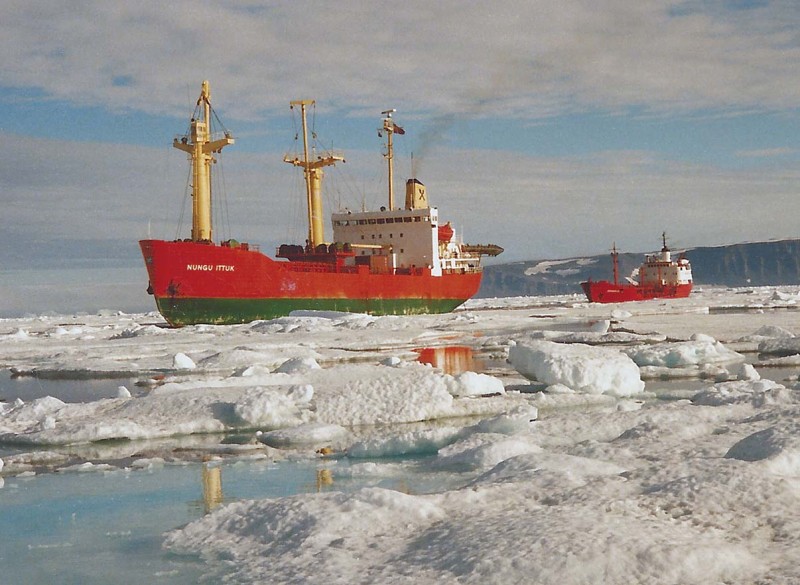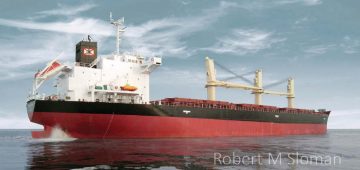Ice Salvage in Scoresbysundfjorden

In July 1988, Nungu Ittuk departed from “Grønlandshavnen” in Aalborg to Scoresbysund in East Greenland. The ship was completely loaded with supplies for towns and villages on the east coast of Greenland. On this voyage we had the helicopter on board to fly isrecco (ice observations).
Nungu Ittuk was built above the Finnish-Swedish Ice class notations 1A Super, and it also had a helicopter deck mounted aft of the super structure. On the voyages north of Tasilaq we usually brought a small helicopter, pilot and mechanic. We also brought a little tug and barge for discharging at these destinations.
Later that month, Nungu Ittuk anch-ored at the anchorage in Scoresbysund for discharging supplies. Both at anchorage and in the Scoresbysund fjord – the world’s largest fjord complex – there was a lot of polar pack ice which had drifted down and out from the further away North polar sea. Both crew on board and workers onshore, however, had extensive experience in loading the barges and then towing the load ashore, so it was altogether a somewhat routine handling of supplies. It was only a few hours’ work and then we could weigh anchor and sail to the next destination, the airfield at Constable Point further into the bay system (Hurry Inlet).
SOS!
Suddenly a message came from our captain: “Stop handling the supplies immediately. We are going to rescue the Betty Teresa. She has broken a propeller blade and can hardy sail through the pack ice in the fjord. The ship’s captain is nervous about being pressed up on the southern rocky coast of the heavy pack ice out there. Moreover, the ship is carrying hundreds of tons of diesel oil which can cause a huge environmental disaster in the fragile Arctic environment in the fjord.”
Betty Teresa is a tanker ship built for sailing in Arctic waters, but it is not nearly as large nor in the same high ice class as Nungu Ittuk. In July 1988, the Betty Teresa was on a voyage to Scoresbysund with several hundred tons of diesel oil destined for the city’s large tank systems. We immediately responded by throwing away everything we had in our hands, and fought our way back to the Betty Teresa through the pack ice. She could not move forward through the ice because of the accident with the screw, but could still manoeuvre a bit. The captains agreed among themselves that the Nungu Ittuk should tug the fully loaded tanker ship Betty Teresa to the anchorage in Scoresbysund. Here she would be able to unload the diesel oil and then be trimmed forward to partially expose the screw. She could then be fitted a new screw blade, replacing the lost one (the ship was built for such an operation), and she could continue to Constable Point air field with jet fuel.
Salvage
The captain of Nungu Ittuk then sailed right up to the Betty Teresa, and our mooring lines were installed as towing lines. We were on constant guard with a ‘fire axe’ to cut the towing lines if we suddenly got stuck in the ice. He then performed some excellent seamanship. He steered and manoeuvred Nungu Ittuk over many, many hours through the heavy polar pack ice while he towed the Betty Teresa which could not go backwards optimally.
The helicopter we brought with us really benefitted us in a whole new way. It was agreed with the pilot that he should bring one of the ship’s navigators for isrecco. This navigator would then assess where it was most navigable for Nungu Ittuk with the tanker in tow. He should then have the pilot land on a suitable ice floe so that the captain of Nungu Ittuk had the helicopter to steer by.
Note that it was almost impossible for Nungu Ittuk to break its way through the very thick and very hard polar pack ice. The ship had to sail where there was a little open water between the polar ice floes.

The assessment could only apply for a short period of time as wind and currents constantly grind pack ice around into new positions. Luckily, the weather and wind conditions were very favorable throughout the salvage operation and we proceeded well. We were in anchorage after many hours of towing and then continued with discharging supplies.
Oh No – Not Again!
After the unloading at Scoresbysund, we had now arrived at the air field at Constable Point, and here we now repeated our routine discharging of supplies via barge. When we were getting ready for the voyagea back to Grønlandshavnen in Aalborg, the alarm suddenly sounded. We must come down and tow the Betty Teresa from Scoresbysund to Constable Point. It appeared that now the large diesel oil tank in Scoresbysund could not receive enough diesel oil from the Betty Teresa to enable the ship to be trimmed enough for the repairs of the screw. Afterwards we continued the trip to Aalborg/ Grønlandshavnen without further drama.
Since 1988 I have often wondered what the authorities would have done to salvage the Betty Theresa in the very icy fjord to avoiding a potential major pollution of the world’s largest fjord complex if the polar ship Nungu Ittuk had not been in Scoresbysundfjorden at this fortuitous time?
In 2010, there was a huge marine pollution with crude oil under the Deepwater Horizon disaster in the Gulf of Mexico. I find it very interesting that this huge oil spill could actually fit in just three crude oil tankers given the size of the crude oil tanker Exxon Valdez.

Comments
Sorry, comments are closed for this item